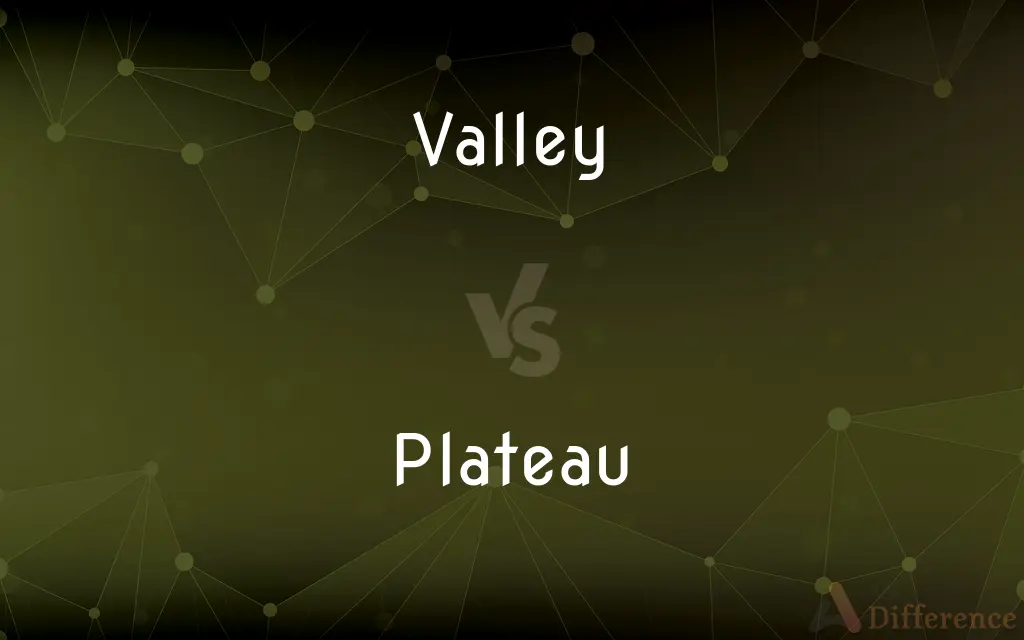Valley vs. Plateau — What's the Difference?
Edited by Tayyaba Rehman — By Urooj Arif — Updated on March 18, 2024
Valley refers to a low area between hills or mountains, often with a river running through it, while plateau is an elevated flatland that stands significantly above the surrounding area.

Difference Between Valley and Plateau
Table of Contents
ADVERTISEMENT
Key Differences
A valley is characterized by its elongated depression in the landscape, typically situated between ranges of hills or mountains. It may be formed by geological processes such as erosion by rivers or glacial activity. Valleys are known for their fertile lands and are often inhabited due to their availability of water and arable land. In contrast, a plateau, also known as a high plain or tableland, is a flat, elevated landform that rises sharply above the surrounding area on at least one side. Plateaus are formed by various geological processes, including uplift, lava eruption, and erosion.
Valleys often serve as conduits for rivers and streams, providing natural pathways for water to travel from higher elevations to lower points, such as seas or larger rivers. This makes valleys crucial for water ecosystems and human settlements. Plateaus, however, may have a more arid climate due to their elevation and can be less suitable for intensive agriculture. They often host unique ecosystems adapted to higher altitudes and can be sources of minerals and other natural resources.
The formation of valleys is usually a result of erosion, a process that takes millions of years. The landscape is shaped by the continuous flow of water, cutting through rock and soil. Plateaus, on the other hand, can be formed through volcanic activity, where lava flows and hardens, or through the uplift of tectonic plates, creating flat, elevated areas that are not easily eroded.
Valleys are often synonymous with scenic beauty, offering picturesque landscapes with rivers, streams, and varied vegetation. They are also important for agriculture due to the fertile soil found on valley floors. Plateaus offer their own unique beauty, with wide-open spaces, cliffs, and sometimes spectacular land formations. Their elevation can provide stunning vistas of the surrounding landscapes.
Both valleys and plateaus play significant roles in the environment and human culture. Valleys, with their water sources, are often cradles of civilization and agriculture. Plateaus can be rich in minerals and serve as important cultural and historical sites, offering unique habitats for wildlife and flora adapted to the high-altitude conditions.
ADVERTISEMENT
Comparison Chart
Definition
A low area between hills or mountains, often with a river
An elevated flatland above the surrounding area
Formation
Formed by erosion from rivers or glaciers
Formed by uplift, volcanic activity, or erosion
Characteristics
Elongated depression, fertile lands, water pathways
Flat, elevated land, potentially arid, unique ecosystems
Climate
Can vary but often supports agriculture and settlements
Often arid, with temperature variations due to elevation
Ecological Role
Supports diverse ecosystems, crucial for water flow
Hosts unique flora and fauna, mineral resources
Human Interaction
Cradles of civilization, agriculture, scenic beauty
Cultural and historical significance, mining, unique beauty
Compare with Definitions
Valley
A low area between mountains or hills.
The Nile Valley is known for its historical significance and fertile lands.
Plateau
An elevated flatland higher than the surrounding area.
The Tibetan Plateau is often called the Roof of the World.
Valley
Valleys formed by river erosion.
The Grand Canyon is a striking example of a river valley.
Plateau
Surrounded by mountains on all sides.
The Colorado Plateau is an example of an intermontane plateau.
Valley
Carved by glacial activity.
Yosemite Valley was shaped by glacial forces.
Plateau
Formed by lava flows.
The Deccan Plateau in India was formed by volcanic activity.
Valley
Valleys known for their natural beauty.
The Valley of Flowers in India attracts nature enthusiasts worldwide.
Plateau
Eroded into hills and valleys.
The Ozark Plateau has been dissected by erosion over time.
Valley
Valleys with rich soil conducive to agriculture.
The Loire Valley in France is renowned for its vineyards.
Plateau
High elevation plateaus.
The Ethiopian Highlands are also known as the Ethiopian Plateau.
Valley
A low area of land between hills or mountains, typically with a river or stream flowing through it
The valley floor
The Thames Valley
Plateau
An area of fairly level high ground.
Valley
A valley is an elongated low area often running between hills or mountains, which will typically contain a river or stream running from one end to the other. Most valleys are formed by erosion of the land surface by rivers or streams over a very long period of time.
Plateau
A state of little or no change following a period of activity or progress
The peace process had reached a plateau
Valley
An internal angle formed by the intersecting planes of a roof, or by the slope of a roof and a wall.
Plateau
In geology and physical geography, a plateau ( , , or ; French: [pla.to]; plural plateaus or plateaux), also called a high plain or a tableland, is an area of a highland consisting of flat terrain, that is raised sharply above the surrounding area on at least one side. Often one or more sides have deep hills.
Valley
An elongated lowland between ranges of mountains, hills, or other uplands, often having a river or stream running along the bottom.
Plateau
Reach a state of little or no change after a period of activity or progress
The industry's problems have plateaued out
Valley
An extensive area of land drained or irrigated by a river system.
Plateau
An elevated, comparatively level expanse of land; a tableland.
Valley
A depression or hollow resembling or suggesting a valley, as the point at which the two slopes of a roof meet.
Plateau
A relatively stable level, period, or state
Mortgage rates declined, then reached a plateau.
Valley
An elongated depression cast between hills or mountains, often garnished with a river flowing through it.
Plateau
To reach a stable level; level off
"The tension seemed to grow by degrees, then it plateaued" (Tom Clancy).
Valley
An area which drains itself into a river.
Plateau
A largely level expanse of land at a high elevation; tableland.
Valley
Any structure resembling one, e.g. the interior angle formed by the intersection of two sloping roof planes.
Plateau
(of a varying quantity) A comparatively stable level after a period of increase.
Valley
To form the shape of a valley.
Plateau
(dated) An ornamental dish for the table; a tray or salver.
Valley
The place of meeting of two slopes of a roof, which have their plates running in different directions, and form on the plan a reëntrant angle.
Plateau
A notable level of attainment or achievement.
Valley
A long depression in the surface of the land that usually contains a river
Plateau
(intransitive) (of a varying quantity) To reach a stable level after a period of increase; to level off.
Plateau
A flat surface; especially, a broad, level, elevated area of land; a table-land.
Plateau
An ornamental dish for the table; a tray or salver.
Plateau
A relatively flat highland
Common Curiosities
What are the benefits of valleys to human civilization?
Valleys offer water sources, fertile land for agriculture, and natural protection, making them favorable sites for human settlement and development.
What makes a valley different from a canyon?
Valleys are generally broader and less steep than canyons, which are characterized by their deep, narrow profiles with steep sides.
Are valleys always formed by rivers?
While many valleys are formed by river erosion, others can result from glacial activity, tectonic movements, or other geological processes.
Are all valleys fertile?
Many valleys are fertile due to sediment deposition by rivers, but fertility can vary based on the local climate, soil, and other environmental factors.
Can plateaus have water bodies?
Yes, plateaus can host rivers, lakes, and wetlands, though the distribution and size of these water bodies may differ from those in valleys.
How do people live on plateaus?
People adapt to the plateau's climate and terrain, often relying on terrace farming, livestock, and the exploitation of mineral resources.
How does altitude affect climate on plateaus?
Higher altitudes on plateaus can lead to cooler temperatures, reduced atmospheric pressure, and distinct weather patterns compared to surrounding lowlands.
Can a plateau be transformed into a valley?
Over geological timescales, erosion can dissect a plateau into a series of valleys and ridges, but this process takes millions of years.
Why are plateaus important for biodiversity?
Plateaus can host unique ecosystems with species adapted to high-altitude conditions, contributing to global biodiversity.
What cultural significance do plateaus hold?
Plateaus can be sacred or culturally significant due to their unique landscapes, historical events, or as homes to indigenous communities and their traditions.
Share Your Discovery

Previous Comparison
Spoon vs. Scoop
Next Comparison
Annotate vs. NotateAuthor Spotlight
Written by
Urooj ArifUrooj is a skilled content writer at Ask Difference, known for her exceptional ability to simplify complex topics into engaging and informative content. With a passion for research and a flair for clear, concise writing, she consistently delivers articles that resonate with our diverse audience.
Edited by
Tayyaba RehmanTayyaba Rehman is a distinguished writer, currently serving as a primary contributor to askdifference.com. As a researcher in semantics and etymology, Tayyaba's passion for the complexity of languages and their distinctions has found a perfect home on the platform. Tayyaba delves into the intricacies of language, distinguishing between commonly confused words and phrases, thereby providing clarity for readers worldwide.
















































